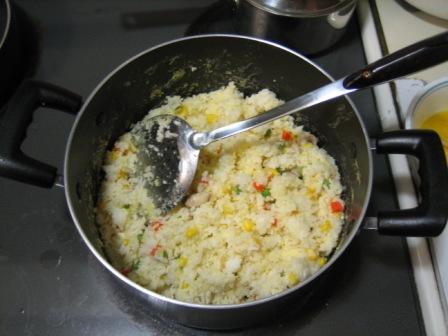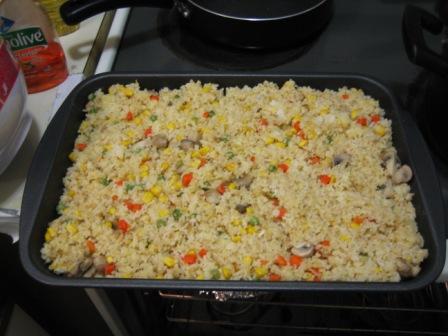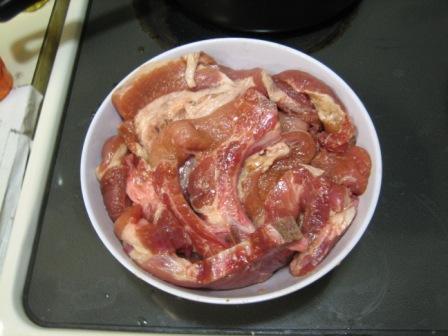Lawson L.S. Wong
|
Ph.D. student (MIT CSAIL) |

|
Lawson L.S. Wong
|
Ph.D. student (MIT CSAIL) |

|
Baked Pork Chop Rice (焗豬扒飯)
This is a classic Hong Kong style dish! Certainly you have to see / try Café de Coral's 一哥焗豬扒飯!
Many thanks to the recipe found here. I provide some modifications and tips here.
The ingredients I used, for a yield of about 12 bowls of rice:
There are two main parts to this dish: fried rice, and pork chop. I will first describe the fried rice, then preparing and frying the pork chop. However, something to consider in practice is that the pork chop needs about an hour to marinate, so if you are short on time you may consider marinating first, then frying rice, then finally frying the pork chop. On the other hand, the fried rice can also be done well in advance (even the day before), whereas it is probably best if the pork chop is only fried close to baking time. The order just depends on your constraints, so make sure to plan well! (Unfortunately, my research can't help you (yet) on that!) Nevertheless, you should always cook the rice well in advance (explained below).
The instructions accompany the pictures.
|
This is the most important component. Without rice, this dish is nothing!
The key to successful fried rice is in its preparation.
It is very difficult to fry rice that contains too much moisture,
so cook the rice well in advance (say, the night before) and keep it in the fridge for a day.
This will suck moisture out of the rice and give the correct consistency upon frying.
Unless you have a large rice cooker, 10 bowls of rice will probably take many times to cook; the easiest way is to give up on automation, and cook rice directly on the stovetop in a large pot. I used the largest pot I had, which could easily cook 20 bowls in one go. It's actually very easy and not much slower than a rice cooker. Simply measure the desired amount of rice, give 1.5 times the amount of water (slight variation depending on type of rice), and cook it on medium high until it boils; keep the heat on medium until a clear rice layer forms (i.e., most of the water is absorbed); then finally put the heat on low for another 10 minutes of so. To test, try poking through for some rice in the middle. A very important step that somehow seems to work is that after cooking, do not immediately remove the rice; take the pot away from the stovetop, and just let the rice cool in the pot (with lid on) for some time. From experience this seems to distribute the moisture more evenly in the rice and avoid sticky rice on the bottom, etc. |

(Note: I took this picture when I made the Seafood Fried Rice Casserole, which called for 30 bowls of rice, so you shouldn't get nearly as much rice shown.) |
|
Before frying the rice itself, everything else (perhaps apart from the pork chop) should be cooked.
For me then, the only thing I had to cook was the vegetables; this was very easy,
just boil the bag of mixed vegetables and mushrooms in water for a reasonable amount of time.
Frying the rice itself is by far the most physically intense and time-consuming part of cooking this dish. Take a reasonable amount of rice (say, 6 bowls) and stir-fry it on high heat. Also make sure to furiously separate the rice, avoiding it from clumping together in the moisture. The goal is to get fluffy, separable grains of rice up to a temperature as if it were just cooked. Once this is done, add in all the pre-cooked (and drained) ingredients, and mix/fry them together! Since everything is cooked already, this is just to mix the flavors together and create a presentable dish. At the end, beat a few eggs and add that to the rice and fry it together; also, soy sauce can also be added at this point for extra taste. With 12 bowls of rice, I had to split frying into 2 times. It took half an hour hour, and it was rather tiring. The good thing about this dish though is that the most time-consuming process, frying the rice, can be done at one's desired pace. Unlike fried rice itself, which should be served hot, since this dish still has to be baked, it doesn't matter if the batches of fried rice turn cold; this gives a nice end consistency and presentation for the dish. |


|
Now, the pork chop.

|

|
|
Frying pork chop is a delicate procedure in that things can go wrong very easily,
resulting in dry meat with poor texture. I myself frequently find myself dissatisfied
with my results, but I will try to extract the commonalities of successful instances
and discuss proper technique in theory.
First, the choice of meat. Fat content is important! Fattier meat in general is more tolerant to errors in cooking, and usually tastes better (at the potential cost of nutrition) (半肥瘦叉燒!). Within the class of pork chops, there are various cuts with different fat content; acquire the type that you feel comfortable cooking, and perhaps gradually hone your skill. A good start would be pork shoulder butt (梅頭). Regardless, we can always remove the remainder of the fat before baking. Make sure the pork chops are defrosted (if frozen) and relatively dry. Marinate the pork chops with soy sauce, sugar, and Chinese cooking wine. Do not add corn starch yet; do so at the end. I cannot give exact amounts because I don't measure exactly, and since this also is a matter of taste, this will come by trial and error. Something good to begin with is 2 tablespoons of soy sauce, 1 tablespoon of sugar, and 1 tablespoon of wine. Mix everything together well, and let it marinate in the fridge (to absorb moisture) for half an hour or more. Take out the meat, and gradually add water (small amounts, be careful!) until the meat is just saturated in moisture, and let it marinate for another 15 minutes or so. If you overshoot, you can try to soak out the extra moisture, or you can set it in the fridge and wait... Finally, add about 1 tablespoon of corn starch and mix evenly. |
Marinating was such a slow and delicate procedure! (Un)fortunately, frying the
pork chops is also rather delicate, but in a very different way.
Wait until the meat is near room temperature (i.e., not just out of the fridge). Turn the frying pan on high heat in preparation for quick and hot frying. Once it reaches a temperature where oil almost starts to evaporate, take the pork chops one piece at a time and start frying them as follows. You will most likely want to do this one piece at a time because it requires a lot of quick attention. Lay the pork chop flat on the pan, making sure the entire surface touches the pan. After 10 seconds, flip the pork chop. After another 10 seconds, flip the pork chop, set the heat on medium, and let each side fry for about 2 minutes. What we have attempted to achieve here is the Maillard reaction, an important browning process that locks the juices inside the meat and prevents flavor and moisture from escaping. (Also see 'Wok hei' (鑊氣).) You will notice the physical browning on parts of the pork chop shown above. Once this process becomes familiar, you can try to increase the throughput, such as above where I attempted three in one go. The same process applies to each piece, just try to set all 3 pieces in 10 seconds, flip them, etc. It is important to remember that to ensure the Maillard reaction works, all meat must always be flat and touch the pan surface (no overlapping / overcrowding!), the heat must be high initially and turned to medium after the initial 20 seconds, and the meat should not be flipped too often. After about 2 minutes of frying on each side, the pork chops should look slightly more cooked than above (the blood should mostly be gone). Although it is not fully done yet (still some pinkish meat inside) and pork should be well done, it is alright to remove the pork because it will still cook by itself due to internal heat, and because we still will bake the pork chop later. |
For the pork to be more easily edible, and to double-check that it is sufficiently well done, it is recommended that you cut the pork into reasonable pieces. You can also remove the 'training fat' if you wish. Cover the fried rice evenly with the pieces of pork chop, and coat it all in the thick layer of tomato paste (it must be sufficiently thick, so tomato puree or sauce are not valid substitutes). A 29 oz can is a good amount - it will just be able to cover all the rice and meat. Covering the meat in sauce is essential to prevent it from drying up during the baking process; this is also an advantage of cutting the meat into smaller pieces, to increase the surface area in contact with the sauce. You can also add assorted complementary vegetables on top too, such as tomato and pineapple chunks. Finally, sprinkle cheese on top if desired, and bake at 200 °C for 20-30 minutes. Done!
Back to Recipes